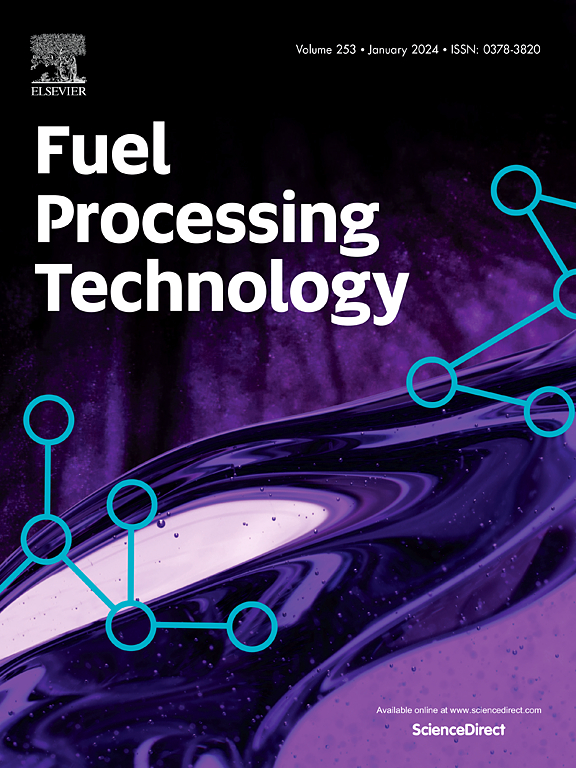Photosynthesis of polypyyrole/ZnFe2O4-WO3 nanocomposite for biodiesel production
IF 7.2
2区 工程技术
Q1 CHEMISTRY, APPLIED
引用次数: 0
Abstract
In this study, photolysis-free radical polymerization is successfully employed to synthesis a heterogeneous Polypyrrole/ZnFe2O4-WO3 nanocomposite. The photolysis technique was used UV irradiation with 15 W and 365 nm for reduction ferric, zinc and tungsten aqueous precursors for synthesis of metal oxides nanocomposite. The synthesized nanocomposite were characterized via X-ray diffraction (XRD), Fourier Transform Infrared Spectroscopy (FTIR), X-ray photoelectron spectroscopy (XPS) and Raman spectrum and used it in transesterification of oil to investigate of the catalytic performance. The nanocomposite catalyst appeared high activity for esterification of olive oil creating from the increasing the diffusion between the reactant and product. Furthermore, the prepared nanocomposite catalyst could be easily recovered and efficiently reused for many times without considerable loss in its activity, also appeared results showed that PPy/ZnFe2O4-WO3 nanocomposite could be employed for the suitable and rapid biodiesel production. Depending on the experimental results, the optimum conditions with yield 94 % show at 1:14 oil/methanol ratio, 120 min, 55 °C temperature and 3 % catalyst dose. The obtained biodiesel appeared properties near to those of international standards of biodiesel. The product met international standards for key features, including density, viscosity and flash point, as well as, the catalyst appeared excellent reusability, keeping efficiency over multiple cycles with lower performance loss. These results proved the prepared catalyst as a cost-effective and sustainable catalyst for biodiesel production.

聚吡咯/ZnFe2O4-WO3纳米复合材料在生物柴油生产中的光合作用
本研究成功地采用光解-自由基聚合法制备了非均相聚吡咯/ZnFe2O4-WO3纳米复合材料。采用15w和365nm紫外光解技术,还原铁、锌、钨水相前驱体,合成金属氧化物纳米复合材料。采用x射线衍射(XRD)、傅里叶变换红外光谱(FTIR)、x射线光电子能谱(XPS)和拉曼光谱对合成的纳米复合材料进行了表征,并将其应用于油脂酯交换反应中考察其催化性能。纳米复合催化剂对橄榄油的酯化反应表现出较高的催化活性,这是由于增加了反应物与产物之间的扩散。此外,所制备的纳米复合催化剂易于回收和高效重复使用,且其活性损失不大,还表明PPy/ZnFe2O4-WO3纳米复合材料可用于合适且快速的生物柴油生产。根据实验结果,油甲醇比为1:14,反应时间为120 min,反应温度为55℃,催化剂用量为3%,收率为94%。所得生物柴油各项性能接近国际生物柴油标准。该产品在密度、粘度和闪点等关键特性上均符合国际标准,催化剂具有优异的可重复使用性,在多次循环中保持效率,性能损失更低。这些结果证明了所制备的催化剂是一种具有成本效益和可持续性的生物柴油催化剂。
本文章由计算机程序翻译,如有差异,请以英文原文为准。
求助全文
约1分钟内获得全文
求助全文
来源期刊

Fuel Processing Technology
工程技术-工程:化工
CiteScore
13.20
自引率
9.30%
发文量
398
审稿时长
26 days
期刊介绍:
Fuel Processing Technology (FPT) deals with the scientific and technological aspects of converting fossil and renewable resources to clean fuels, value-added chemicals, fuel-related advanced carbon materials and by-products. In addition to the traditional non-nuclear fossil fuels, biomass and wastes, papers on the integration of renewables such as solar and wind energy and energy storage into the fuel processing processes, as well as papers on the production and conversion of non-carbon-containing fuels such as hydrogen and ammonia, are also welcome. While chemical conversion is emphasized, papers on advanced physical conversion processes are also considered for publication in FPT. Papers on the fundamental aspects of fuel structure and properties will also be considered.
 求助内容:
求助内容: 应助结果提醒方式:
应助结果提醒方式:


